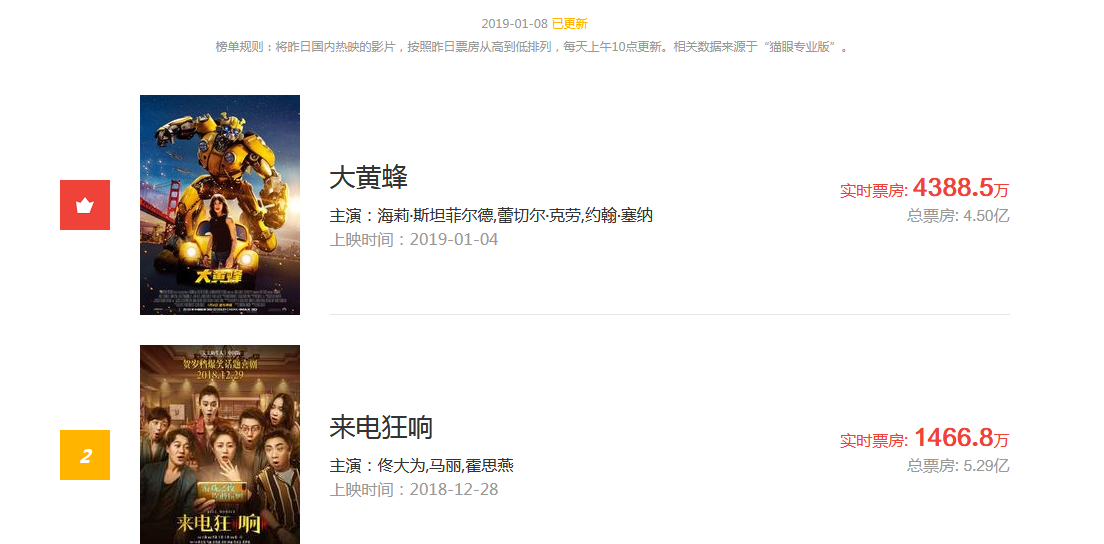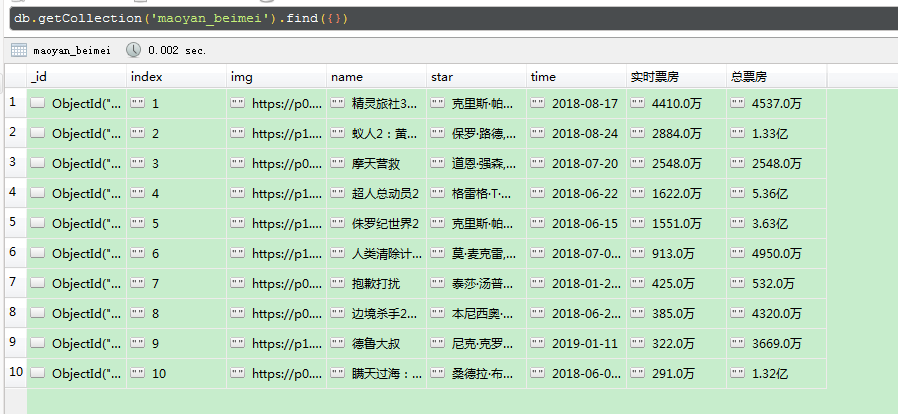猫眼票房排行榜页面显示如下:

注意右边的票房数据显示,爬下来的数据是这样显示的:

网页源代码中是这样显示的:

这是因为网页中使用了某种字体的缘故,分析源代码可知:

亲测可行:
代码中获取的是国内票房榜,稍加修改也可适用于最受期待榜和北美票房榜
解决思路如下:
1.获取网页数据后,查找字体信息,获取到字体链接,下载字体保存到本地
2.使用fontTools读取字体中的字符集,并构造字典(依据基准字体)
3.根据字典,替换网页中的相关数据信息。
注意:如果使用BeautifulSoup一定要先使用字典替换字符集,再解析。直接解析BeautifulSoup会将无法识别的字符置为空。
#!/usr/bin/env python
# -*- coding: utf-8 -*-
"""
@Project:pachong
@author:sandu
@Email: sandu12345@msn.cn
@Software: PyCharm
@file: test_maoyan.py
@time: 2019-01-08 0008 上午 10:05
"""
import csv
import json
import os
import re
from hashlib import md5
import pymongo
import requests
from fontTools.ttLib import TTFont
from requests.exceptions import RequestException
import woff2otf
MONGO_URL = 'localhost'
MONGO_DB = 'maoyan'
MONGO_TABLE = 'maoyan_beimei'
client = pymongo.MongoClient(MONGO_URL, connect=False)
db = client[MONGO_DB]
# 获取单页数据
def get_one_page(url):
try:
response = requests.get(url)
if response.status_code == 200:
return response.text
return None
except RequestException:
return None
# 解析单页数据,获取所需的数据
# '.*?board-index.*?>(d+).*?' 获取顺序号
# '.*?data-src="(.*?)".*?' 获取图片链接
# '.*?name.*?title.*?>(.*?)</a>.*?' 获取电影名称
# '.*?star">(.*?)</p>.*?',re.S 获取演员名单(有换行,需要加上re.S,否则获取不到数据)
# '.*?releasetime">(.*?)</p>.*?' 获取上映时间
# '.*?integer">(.*?)</i>.*?' 获取主分
# '.*?fraction">(.*?)</i>.*?'获取辅分
# '.*?realtime.*?stonefont">(.*?)</span></span>(.*?)</p>.*?' 实时票房
# '.*?total-boxoffice.*?stonefont">(.*?)</span></span>(.*?)</p>.*?' 总票房
# 综合下来,加上最外层的dd
def parse_one_page(html):
pattern = re.compile(
'<dd>.*?board-index.*?>(d+).*?data-src="(.*?)".*?name.*?title.*?>(.*?)</a>.*?star">(.*?)</p>.*?releasetime">(.*?)</p>.*?realtime.*?stonefont">(.*?)</span></span>(.*?)</p>.*?total-boxoffice.*?stonefont">(.*?)</span></span>(.*?)</p>.*?</dd>',
re.S)
items = re.findall(pattern, html)
for item in items:
yield {
'index': item[0],
'img': item[1],
'name': item[2].strip(), # 去除前后空格换行符等
'star': item[3].strip()[3:], # 去除前后空格换行符等,切片截取指定的范围
'time': item[4][5:],
'实时票房': item[5] + item[6].strip(),
'总票房': item[7] + item[8].strip(),
}
# 保存至文件
def save_to_file(content):
# 注意:把json数据保存到文件中显示出中文
with open('beimei.text', 'a', encoding='utf-8') as f:
f.write(json.dumps(content, ensure_ascii=False) + '
')
# 保存到数据库中
def save_to_mongo(result):
if db[MONGO_TABLE].insert(result):
print('Successfully Saved to Mongo', result)
return True
return False
# 请求图片url,获取图片二进制数据
def download_image(url):
try:
response = requests.get(url)
if response.status_code == 200:
save_image(response.content) # response.contenter二进制数据 response.text文本数据
return None
except RequestException:
print('请求图片出错')
return None
# 数据存储到csv
def write_to_file3(item):
with open('beimei.csv', 'a', encoding='utf_8_sig', newline='') as f:
# 'a'为追加模式(添加)
# utf_8_sig格式导出csv不乱码
fieldnames = ['index', 'img', 'name', 'star', 'time', '实时票房', '总票房']
w = csv.DictWriter(f, fieldnames=fieldnames)
w.writerow(item)
# 解析字体
def get_font_regx(html):
p = re.compile(r"url('(.*?)')sformat('woff');") # 查找网页上的字体链接
uni_font_url = re.findall(p, html)
url = 'http:%s' % uni_font_url[0]
resp = requests.get(url)
with open('maoyan.woff', 'wb') as fontfile:
for chunk in resp.iter_content(chunk_size=1024):
if chunk:
fontfile.write(chunk) # 将字体下载到本地
woff2otf.convert('maoyan.woff', 'maoyan.otf')
baseFont = TTFont('base.otf') # base.otf是某一次访问获取的字体文件,然后人工识别内容,作为与后面获取字体的比对标本,从而让电脑自动获得后面获取字体的实际内容。
maoyanFont = TTFont('maoyan.otf')
uniList = maoyanFont['cmap'].tables[0].ttFont.getGlyphOrder() # 解析otf字体后获得的数据
numList = [] # 解析otf字体数据转换成数字
baseNumList = ['.', '3', '5', '1', '2', '7', '0', '6', '9', '8', '4']
baseUniCode = ['x', 'uniE78E', 'uniF176', 'uniEFE6', 'uniF074', 'uniE9C8', 'uniE912', 'uniEA71', 'uniE74E',
'uniE4B8', 'uniEE71']
for i in range(1, 12):
maoyanGlyph = maoyanFont['glyf'][uniList[i]]
for j in range(11):
baseGlyph = baseFont['glyf'][baseUniCode[j]]
if maoyanGlyph == baseGlyph:
numList.append(baseNumList[j])
break
uniList[1] = 'uni0078'
new_dict = dict(zip(uniList[2:], numList[1:])) # 实时获取字体映射关系
html = html.replace('&#x', 'uni')
for key in new_dict.keys():
initstr = key.lower() + ';'
html = html.replace(initstr, new_dict[key])
return html
def save_image(content):
file_path = '{0}/{1}.{2}'.format(os.getcwd(), md5(content).hexdigest(), 'jpg')
if not os.path.exists(file_path):
with open(file_path, 'wb') as f:
f.write(content)
def main(offset):
url = 'https://maoyan.com/board/2?offset=' + str(offset) # 针对分页
html = get_one_page(url)
html = get_font_regx(html)
for item in parse_one_page(html):
print(item)
save_to_file(item) # 保存至文件
write_to_file3(item) # 写入到csv文件中,一定要写在保存到数据库的前面,因为先保存到数据库后保存的字典数据中会多一个_id值
save_to_mongo(item) # 保存到数据库
# download_image(item['img']) # 下载图片保存到当前目录
if __name__ == '__main__':
# for i in range(0, 100):
# main(str(i*10))
# 开启多线程
# pool = Pool()
# pool.map(main,0)
main(0)
# 注:如何获取代码中base.otf相关信息?
# 1.根据获取到的woff字体文件,使用百度字体编辑器,获取字体数字等相关信息,地址:http://fontstore.baidu.com/static/editor/index.html

# 2.将获取到的woff文件使用woff2otf.convert('maoyan.woff', 'base.otf')转化成base.otf文件保存到当前目录(./woff2otf.py font.woff font.otf),从而获得baseFont(代码中变量)
# 3.根据百度字体编辑器获取到的信息,构造baseNumList和baseUniCode(代码中变量)
# 4.再次发起请求根据获得的字体跟这个构造的基准字体进行对照,从而获得新的字体映射关系
# 注: woff2otf是导入的一个py文件,链接地址:https://github.com/hanikesn/woff2otf,作用是输入woff字体,输出otf字体
# 保存到csv文件中

# 保存到MongoDB数据库中
